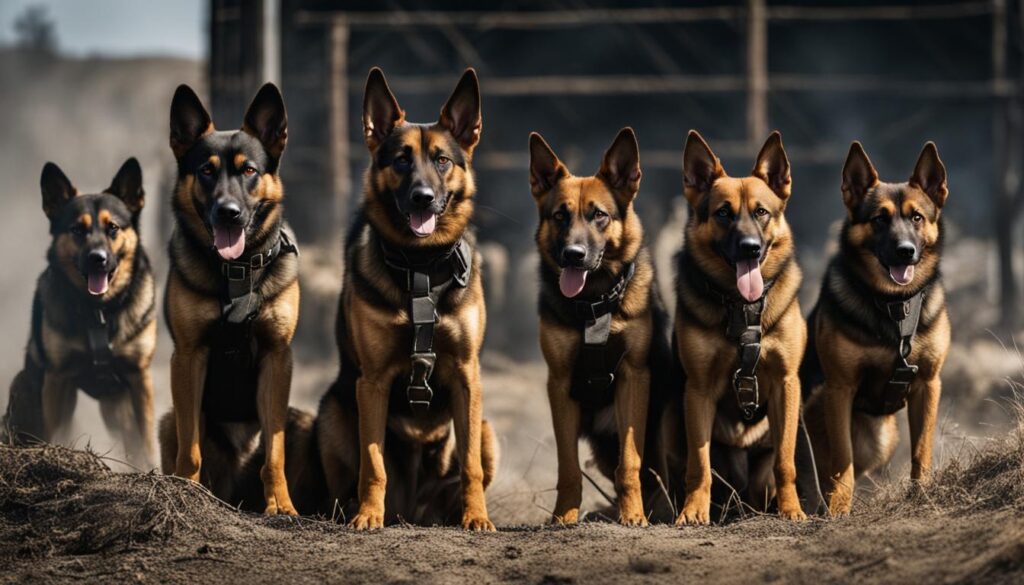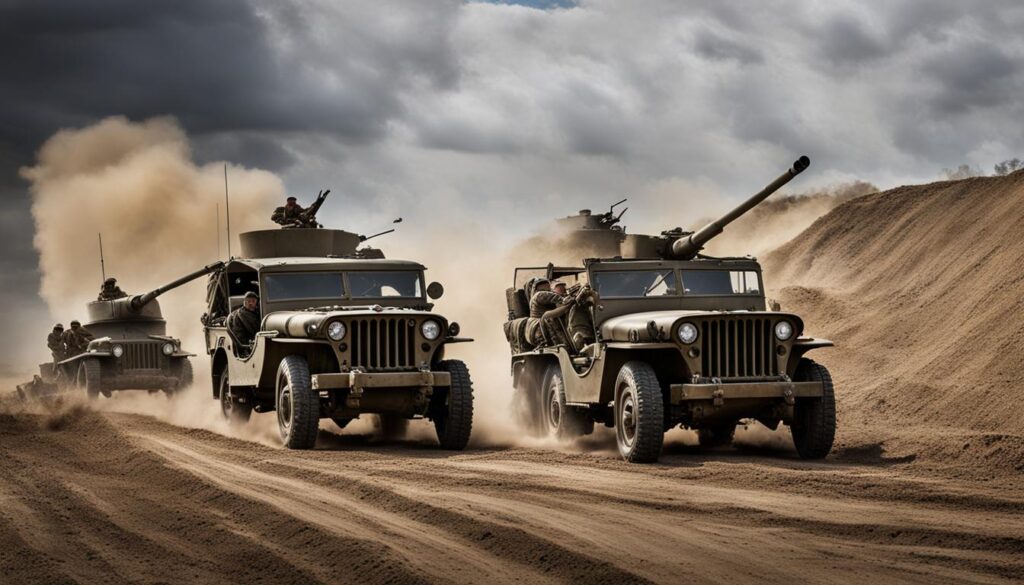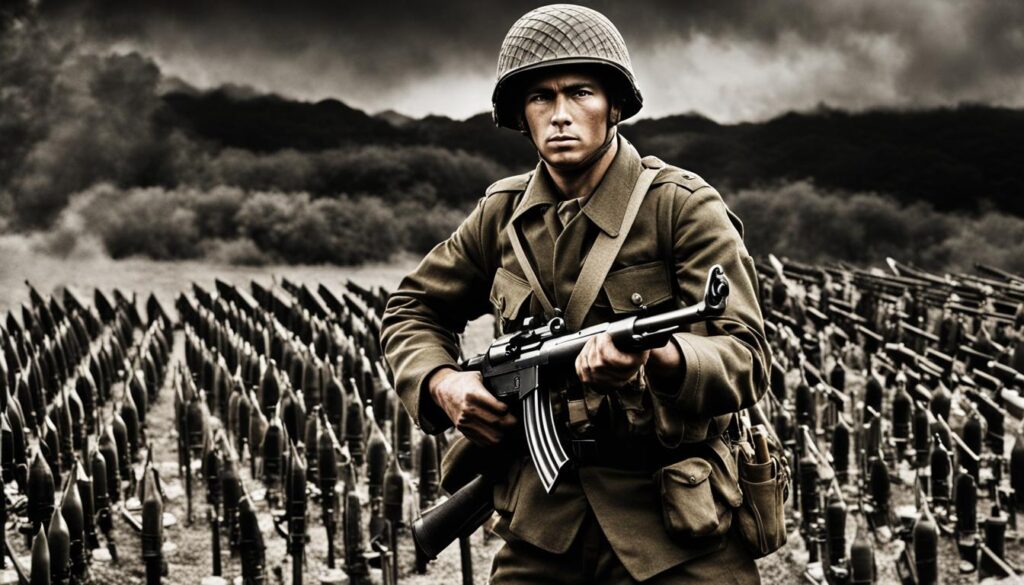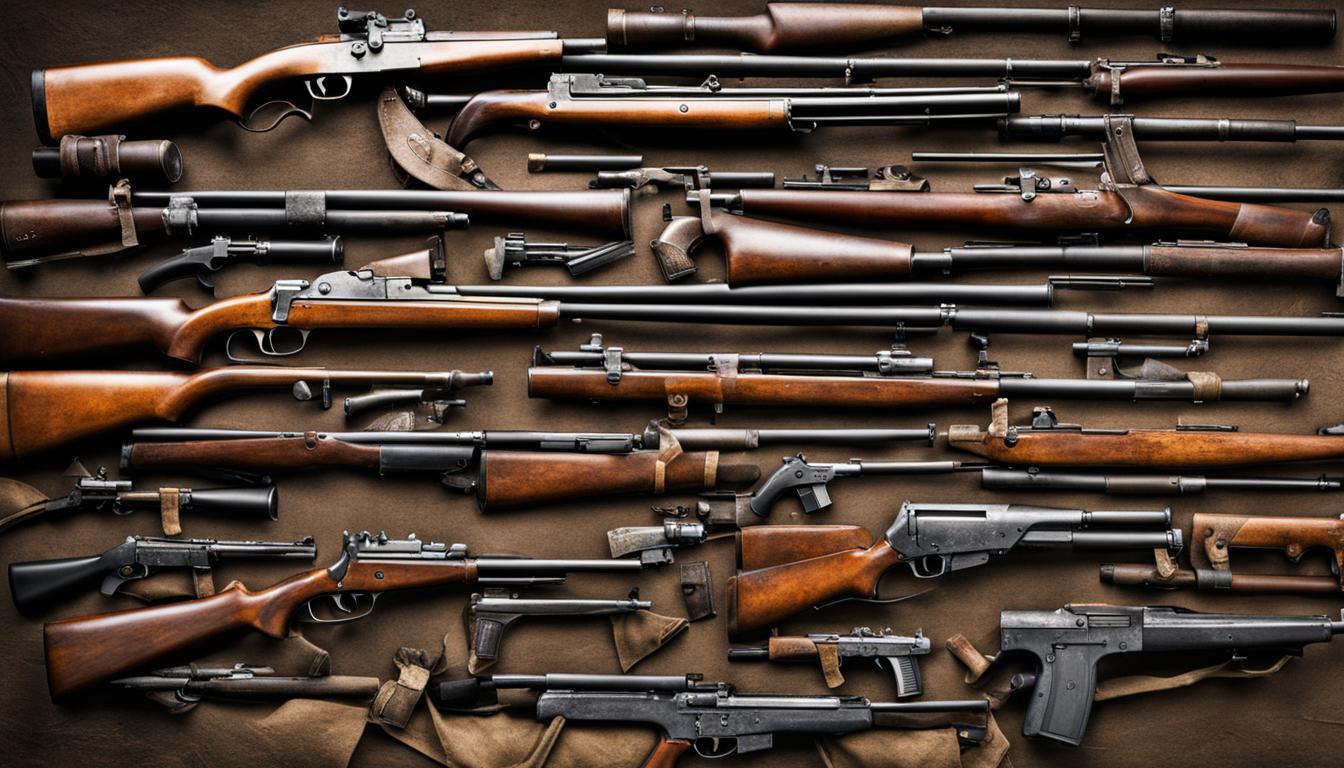World War II was a time of rapid technological innovation, particularly in the development of weapons. In this article, I will explore the fascinating history of World War II weapons and their impact on shaping the world today. From iconic war weapons to tanks, artillery, aircraft, and naval weapons, we will delve into the various types of military equipment used during this global conflict.
Key Takeaways:
- World War II witnessed significant advancements in weapon technology.
- We will explore a range of weapons used during the war, including tanks, artillery, aircraft, and naval weapons.
- Unconventional weapons like war dogs and Japanese war balloons will also be discussed.
- Firearms, artillery, and tanks played crucial roles in shaping the strategies and outcomes of battles.
- The legacy of World War II weapons continues to influence modern warfare.
War Dogs – An Unconventional Soviet Weapon
Dogs played a significant role in World War II, particularly in the Soviet Union. They were used for security, search duties, and even as weapons of war. The most extreme example was the use of dogs trained to destroy enemy tanks by carrying explosives on their backs. However, this unconventional method of warfare proved to be ineffective, with many dogs becoming confused and some even blowing up their own handlers. The Soviets eventually abandoned this tactic.
“The use of war dogs was an innovative yet ultimately flawed strategy,” explains military historian Dr. Ivan Petrov. “While the idea of using dogs as anti-tank weapons seemed promising, it quickly became clear that the dogs were easily disoriented by the chaos of the battlefield. In many cases, they would become terrified and run back to their own lines, causing friendly casualties instead of destroying enemy tanks.”
The Soviets initially trained the dogs to associate food with tanks, so they would run under enemy vehicles to reach the source of their reward. The dogs were then fitted with explosives and sent towards enemy tanks in the hopes that they would detonate upon contact. However, the noise, smoke, and confusion of the battlefield proved to be overwhelming for the dogs, leading to their failure as effective weapons.
Despite the challenges faced by the Soviet Union in using war dogs as weapons, their contributions in other areas should not be overlooked. Dogs were still used for various tasks, such as pulling sleds, carrying messages, and providing companionship to soldiers. The bond between soldiers and their canine companions offered a small but meaningful respite from the harsh realities of war.

| Dog Breed | Training Method | Outcome |
|---|---|---|
| German Shepherd | Explosives on their backs | Ineffective – often blew up their own handlers |
| Belgian Malinois | Running under tanks for food rewards | Disoriented and confused by the chaos of the battlefield |
| Husky | Pulling sleds and carrying messages | Successful in non-combat roles |
Japanese War Balloons – A Desperate Attempt to Beat the US

The Japanese war balloons were a desperate attempt by Japan to attack the United States during World War II. These unmanned balloons were equipped with either incendiary or high explosive devices and were launched from Japan, carried by the jet stream, to fall over US or Canadian territory. The goal was to cause damage and fear among the civilian population.
Despite launching thousands of balloons, only a few actually made it to land, and the damage caused was minimal. The only recorded casualties were a woman and six children in Oregon who stumbled upon a balloon device. The Japanese war balloons failed to achieve their intended purpose of significantly impacting the war effort.
This unconventional weapon of war showcased the desperation of the Japanese military towards the end of the conflict. It highlights the lengths to which nations would go to find new ways to attack their enemies. However, the Japanese war balloons ultimately proved to be an ineffective strategy, overshadowed by the more significant military developments and tactics utilized by the United States and its allies.
The table below provides a comparison between the Japanese war balloons and other weapons used during World War II:
| Weapon | Effectiveness | Impact |
|---|---|---|
| Japanese War Balloons | Low | Minimal |
| Tanks and Armored Vehicles | High | Significant |
| Aircraft | High | Crucial in gaining air superiority |
| Naval Weapons | High | Played a critical role in naval warfare |
| Small Arms | Moderate | Essential for infantry combat |
As seen in the table, the Japanese war balloons had low effectiveness and minimal impact compared to other weapons used during World War II. This further underscores their failure as a strategic weapon.
American WWII Vehicles
In World War II, the American military relied on a diverse range of vehicles to support their operations. These vehicles played crucial roles in transportation, engineering, reconnaissance, and more. Let’s take a closer look at some of the notable American WWII vehicles.
DUKW – The Amphibious Truck
One of the standout vehicles used by the Americans was the DUKW, commonly known as the “Duck.” This versatile amphibious truck was capable of transporting troops and cargo both on land and water. Its ability to traverse various terrains, including rivers and lakes, made it a valuable asset in amphibious assaults and supply operations.
Bulldozers and Halftracks – Enhancing Mobility
The American military also utilized bulldozers and halftracks to improve mobility on the battlefield. Bulldozers were instrumental in clearing obstacles, creating makeshift roads, and building fortifications. Meanwhile, halftracks provided mechanized infantry with the necessary mobility to keep up with armored units, enabling swift and coordinated attacks.
Jeep and Trucks – Versatile Workhorses
No discussion of American WWII vehicles would be complete without mentioning the iconic Jeep. This versatile vehicle served multiple purposes, from reconnaissance and communication to transportation of troops and supplies. Its reliability and off-road capabilities made it an invaluable asset on the battlefield.
Trucks also played a crucial role in supporting military operations. They were responsible for transporting troops, fuel, food, and other essential supplies to the frontlines. These dependable workhorses ensured that the American forces remained well-equipped and mobile.
| Vehicle | Function |
|---|---|
| DUKW | Amphibious transportation |
| Bulldozers | Obstacle clearance and road construction |
| Halftracks | Mechanized infantry mobility |
| Jeep | Reconnaissance, transport, communication |
| Trucks | Troop and supply transport |
The American WWII vehicles showcased the innovation and adaptability of the American military during this global conflict. Whether it was the versatility of the DUKW, the mobility provided by bulldozers and halftracks, or the reliability of the Jeep and trucks, these vehicles played vital roles in the success of American operations.

WWII Firearms
In World War II, firearms played a crucial role on the battlefield. Soldiers were equipped with a variety of weapons designed to engage the enemy at different ranges and with varying firepower. Rifles were the primary armament for infantry soldiers, providing accurate long-range fire. The M1 Garand rifle, used by the American forces, was renowned for its reliability and superior firepower.
Carbines, on the other hand, were shorter and lighter than rifles, making them more maneuverable in close quarters. These weapons were ideal for paratroopers, tank crew members, and other specialized troops who required a compact firearm.
Machine guns also played a significant role in World War II. These weapons provided sustained and suppressive fire, allowing infantry units to control the battlefield and keep the enemy at bay. The German MG42, known as “Hitler’s buzzsaw,” was one of the most feared machine guns of the war, capable of firing up to 1,200 rounds per minute.

| Firearm | Country | Caliber |
|---|---|---|
| M1 Garand | United States | .30-06 Springfield |
| Lee-Enfield | United Kingdom | .303 British |
| Mosin-Nagant | Soviet Union | 7.62x54mmR |
| Karabiner 98k | Germany | 7.92x57mm Mauser |
These firearms were instrumental in shaping combat tactics and strategies during World War II. The development of these weapons had a profound impact on the outcome of battles and campaigns, as they provided soldiers with the means to engage the enemy effectively.
Artillery and Mortars
During World War II, artillery and mortars played a crucial role in providing heavy firepower on the battlefield. These weapons were instrumental in shelling enemy positions, supporting ground troops, and demolishing obstacles. The development of more advanced artillery systems allowed for improved accuracy and range, giving a significant advantage to those who possessed these weapons.
Artillery refers to large-caliber firearms that are capable of launching projectiles over long distances. It includes cannons, howitzers, and field guns. These weapons were used to rain down explosive shells on enemy positions, causing significant damage and forcing the enemy to retreat. Artillery units were often positioned behind the front lines and provided crucial support to the infantry by suppressing enemy defenses.
“Artillery adds dignity, to what would otherwise be an ugly brawl.” – Frederick the Great
Mortars, on the other hand, are portable weapons that launch projectiles at a higher angle than artillery. They are known for their high trajectory and short range, making them ideal for engaging enemy forces in trenches, bunkers, or fortified positions. Mortar teams were able to provide direct support to the infantry, quickly adjusting their fire to neutralize enemy threats.
Overall, the firepower provided by artillery and mortars played a significant role in the success of ground operations during World War II. The ability to accurately target and destroy enemy positions gave forces a distinct advantage on the battlefield, allowing them to advance and secure key objectives.
Table: Comparison of Artillery and Mortars
| Attribute | Artillery | Mortars |
|---|---|---|
| Range | Long | Short |
| Mobility | Less mobile | Portable |
| Projectile Trajectory | Lower angle | Higher angle |
| Target Type | General enemy positions | Trenches, bunkers, fortified positions |
| Firepower | High | High |
Tanks and Armored Vehicles
Tanks and armored vehicles played a pivotal role in World War II, revolutionizing warfare and shaping the tactics employed on the battlefield. These powerful machines provided mobile firepower and crucial protection for ground troops, allowing for armored warfare strategies to be employed to devastating effect.
At the forefront of tank development during World War II were nations such as Germany, the Soviet Union, and the United States. Each country sought to create tanks with thicker armor, more powerful guns, and improved mobility to gain the upper hand in battle. Tanks became a symbol of military might and were employed in various roles, including as breakthrough units, infantry support, and reconnaissance vehicles.
Armored vehicles, such as halftracks and armored cars, also played a significant role in World War II. These versatile vehicles provided both transportation and protection for troops as they maneuvered across the battlefield. Halftracks, in particular, were widely used by mechanized infantry, combining the mobility of wheeled vehicles with the off-road capabilities of tracks.
Table: Comparison of World War II Tanks
| Tank Model | Country of Origin | Armor Thickness (mm) | Main Gun Caliber (mm) | Top Speed (km/h) |
|---|---|---|---|---|
| T-34 | Soviet Union | 45 | 76 | 53 |
| Panzer IV | Germany | 80 | 75 | 42 |
| Sherman | United States | 76 | 75 | 40 |
Despite their technological advancements, tanks were not without weaknesses. The increased use of anti-tank weapons, such as bazookas and anti-tank mines, posed a significant threat to armored vehicles. Additionally, tanks were vulnerable to air attacks, particularly from enemy aircraft armed with bombs or rockets.
In conclusion, tanks and armored vehicles played a crucial role in World War II, providing both offensive and defensive capabilities on the battlefield. Their development and utilization significantly influenced the outcome of battles and campaigns, with nations competing to create more advanced and effective machines. The legacy of these tanks and armored vehicles continues to be felt today, as they remain an integral part of modern military forces.
Aircraft in World War II
Aircraft played a crucial role in World War II, both for reconnaissance and air combat. The development of advanced fighters, bombers, and reconnaissance planes gave nations the upper hand in gaining air superiority. These aerial machines proved to be formidable weapons and were instrumental in shaping the outcome of the war.
One of the most iconic aircraft of World War II was the P-51 Mustang, an American fighter plane that played a significant role in the Allied victory. With its long range and superior performance, the P-51 was able to escort bombers deep into enemy territory, providing protection against enemy fighters. This aircraft was a game-changer, enabling strategic bombing campaigns to be carried out with greater success and minimizing losses.
The P-51 Mustang was not only a powerful fighter but also a symbol of American ingenuity and engineering prowess. Its sleek design and exceptional performance made it a formidable opponent in air-to-air combat, ensuring air superiority for the Allied forces. The P-51 played a crucial role in turning the tide of the war in favor of the Allies.
The Germans also had their share of formidable aircraft, the most notable being the Messerschmitt Bf 109. This German fighter plane was highly maneuverable and well-suited for air combat. It played a key role in the early stages of the war, giving the German Luftwaffe air superiority over the countries it invaded. The Bf 109 proved to be a worthy adversary for the Allied forces, and its effectiveness on the battlefield cannot be understated.
Other aircraft, such as the B-17 Flying Fortress and the Ju 87 Stuka, played significant roles in strategic bombing and close air support, respectively. These planes brought devastating firepower to the enemy and played crucial roles in various military operations.
| Aircraft | Country of Origin | Role | Key Features |
|---|---|---|---|
| P-51 Mustang | United States | Fighter/Bomber | Long-range, high-performance |
| Messerschmitt Bf 109 | Germany | Fighter | Maneuverable, effective in air combat |
| B-17 Flying Fortress | United States | Bomber | Large payload, strategic bombing capabilities |
| Ju 87 Stuka | Germany | Dive Bomber | Precision bombing, close air support |
The aerial battles of World War II were fierce and intense, with skilled pilots from both sides engaged in deadly dogfights. Each aircraft had its strengths and weaknesses, and the outcome of these battles often hinged on the skill and tactics of the pilots involved.
Air Superiority and its Impact
Achieving air superiority was a critical objective for all nations involved in World War II. Control of the skies allowed for the protection of ground forces, the disruption of enemy supply lines, and the strategic bombing of key targets. Without air superiority, military operations would be severely hampered, making it a top priority for all sides.
- Air superiority enabled reconnaissance missions, providing valuable intelligence on enemy positions and movements.
- It allowed for the interception and destruction of enemy aircraft, neutralizing their threat to friendly forces.
- Strategic bombing campaigns could be carried out effectively, targeting enemy infrastructure, industrial centers, and military installations.
- Supporting ground troops with close air support proved vital in gaining the upper hand in battles and offensives.
The aircraft of World War II played a significant role in shaping the outcome of the war. From dogfights in the skies to strategic bombings, these aerial machines were at the forefront of combat operations. Their impact on the battlefield cannot be underestimated, and their legacy continues to be felt in modern warfare.
Naval Weapons of World War II
The naval warfare of World War II saw the deployment of powerful weapons and vessels that played a crucial role in determining the outcome of battles and campaigns. From battleships to cruisers and destroyers, these naval weapons brought incredible firepower to the seas, engaging in long-range engagements and destroying enemy vessels.
“The battleships of World War II were the epitome of naval power, with their massive size and heavy guns. These behemoths, such as the American Iowa-class battleships and the Japanese Yamato-class battleships, boasted powerful artillery capable of engaging targets miles away. They were symbols of naval supremacy and evoked both fear and respect on the battlefield.”
Furthermore, aircraft carriers played a significant role in naval warfare during this period. These floating airbases projected air power at sea, launching airstrikes, conducting reconnaissance missions, and engaging in aerial combat. Aircraft carriers, such as the American USS Enterprise and the Japanese Akagi, demonstrated the importance of air superiority and the ability to strike at the heart of the enemy’s fleet.
To better understand the naval weapons employed during this time, let’s take a look at a table highlighting the key characteristics of battleships and aircraft carriers:
| Weapon | Nation | Length | Displacement | Main Armament |
|---|---|---|---|---|
| Battleship | United States | 887 feet | 45,000 – 57,000 tons | 9 x 16-inch guns |
| Aircraft Carrier | Japan | 855 feet | 36,500 – 39,000 tons | 72-84 aircraft capacity |
| Battleship | Japan | 862 feet | 65,027 – 72,000 tons | 9 x 18.1-inch guns |
| Aircraft Carrier | United States | 968 feet | 60,000 – 83,000 tons | 80-90 aircraft capacity |
As the war progressed, the advent of naval weapons, such as battleships and aircraft carriers, shifted the paradigm of naval warfare. These vessels became crucial in projecting power, defending territories, and engaging in strategic battles at sea.
Naval Weapons Summary
The naval weapons of World War II, including battleships and aircraft carriers, brought immense firepower and strategic capabilities to the seas. Battleships boasted heavy guns and thick armor, symbolizing naval supremacy. Aircraft carriers, on the other hand, projected air power at sea, enabling the launch of airstrikes and engaging in aerial combat. The use of these naval weapons revolutionized naval warfare and played a significant role in shaping the outcome of the war.
Small Arms of World War II
During World War II, small arms played a crucial role in the hands of individual soldiers. These weapons, including pistols, submachine guns, and grenades, provided the necessary firepower for infantry combat. Let’s take a closer look at some of the small arms used during this historic conflict.
Pistols:
Pistols were commonly issued to officers, tank crews, and other personnel who required a compact and lightweight sidearm. The iconic Colt M1911, a semi-automatic pistol chambered in .45 ACP, was widely used by American forces. Its reliability and stopping power made it a favorite among soldiers.
Another notable pistol of World War II was the German Luger P08. This semi-automatic handgun, chambered in 9mm, was known for its distinctive toggle-lock mechanism and sleek design. It was issued to German officers and became synonymous with the German military during this period.
Submachine Guns:
Submachine guns were favored by both Allied and Axis forces for their high rate of fire and compact size. The Thompson submachine gun, or Tommy Gun, became iconic in the hands of American soldiers. It fired .45 ACP rounds and was widely used in close-quarter combat situations.
The German MP40, also known as the Schmeisser, was a submachine gun that became synonymous with the German Army. It fired 9mm rounds and was prized for its reliability and ease of use.
Grenades:
Grenades were essential for infantry combat, allowing soldiers to clear out enemy positions and destroy obstacles. The Mk 2 “Pineapple” grenade, used by American forces, was a hand grenade known for its distinctive shape and deadly effectiveness.
The German Stielhandgranate, or stick grenade, was a widely used grenade by German forces. It featured a long wooden handle and a segmented body, which gave it the appearance of a stick.
These small arms, along with many others, played a significant role in the hands of soldiers during World War II. They exemplified the advancements in weapon technology and provided the means for infantrymen to engage the enemy in various combat scenarios. The effectiveness of these small arms, combined with other weapons of the time, ultimately shaped the strategies and outcomes of this historic conflict.
Conclusion
In conclusion, the weapons of World War II had a significant impact on the outcome of the war and continue to shape our world today. From unconventional tactics like using war dogs to the development of powerful tanks, aircraft, naval weapons, and small arms, the innovations in weaponry influenced the strategies and tactics employed by nations during the conflict.
The use of war dogs, while initially promising, proved to be ineffective and was eventually abandoned by the Soviets. The Japanese war balloons, despite their ambitious goals, caused minimal damage and casualties. However, the American military utilized a wide range of vehicles, including the iconic Jeep, to transport troops and supplies efficiently.
Firearms, artillery, tanks, aircraft, and naval weapons all played crucial roles in World War II. These weapons provided firepower, mobility, and protection, revolutionizing warfare and influencing the outcome of battles and campaigns. The advancements in weaponry during this global conflict significantly shaped combat tactics and strategies, ultimately determining the course of history.
FAQ
Did war dogs play a significant role in World War II?
Yes, war dogs played a significant role, particularly in the Soviet Union. They were used for security, search duties, and even as weapons of war.
Were dogs trained to destroy enemy tanks by carrying explosives on their backs?
Yes, the Soviets trained dogs to carry explosives on their backs to destroy enemy tanks. However, this unconventional method of warfare proved to be ineffective, and the Soviets eventually abandoned it.
Did the Japanese use war balloons during World War II?
Yes, the Japanese launched a bombing campaign using unmanned balloons with attached incendiary or high explosive devices. However, very few of these balloons made it to land, and the damage caused was negligible.
What vehicles did the American military use during World War II?
The American military utilized various vehicles, including the DUKW amphibious truck, bulldozers, halftracks, Jeeps, and trucks, for transportation of troops, cargo, and clearing obstacles.
What types of firearms were used during World War II?
Soldiers were equipped with rifles, carbines, and machine guns during World War II. These firearms provided soldiers with the means to engage the enemy at different ranges and with varying firepower.
What was the role of artillery and mortars in World War II?
Artillery and mortars provided heavy firepower during World War II. They were used to shell enemy positions, support ground troops, and demolish obstacles.
How did tanks and armored vehicles revolutionize warfare during World War II?
Tanks and armored vehicles provided mobile firepower and protection for ground troops, allowing for armored warfare tactics. Their development significantly influenced the outcome of battles and campaigns.
How did aircraft contribute to World War II?
Aircraft played a crucial role in World War II for reconnaissance and air combat. Advanced fighters, bombers, and reconnaissance planes gave nations the upper hand in gaining air superiority.
What role did naval weapons play in World War II?
Naval weapons, such as battleships, cruisers, and destroyers, equipped with powerful guns and torpedoes, allowed for long-range engagements and the destruction of enemy vessels. Aircraft carriers also played a significant role in projecting air power at sea.
What were the main small arms used during World War II?
Small arms such as pistols, submachine guns, and grenades were the mainstay of individual soldiers during World War II. These weapons provided close-quarter firepower essential for infantry combat.
How did the weapons of World War II impact the outcome of the war?
The weapons of World War II, from war dogs to tanks, aircraft, and small arms, shaped the strategies and tactics employed by nations during the conflict. Their development and usage significantly impacted the outcome of battles and campaigns.
Source Links
- https://www.historyonthenet.com/ww2-weapons
- https://www.iwm.org.uk/history/second-world-war-weapons-that-failed
- https://www.amazon.com/U-S-Infantry-Weapons-World-War/dp/0917218671

